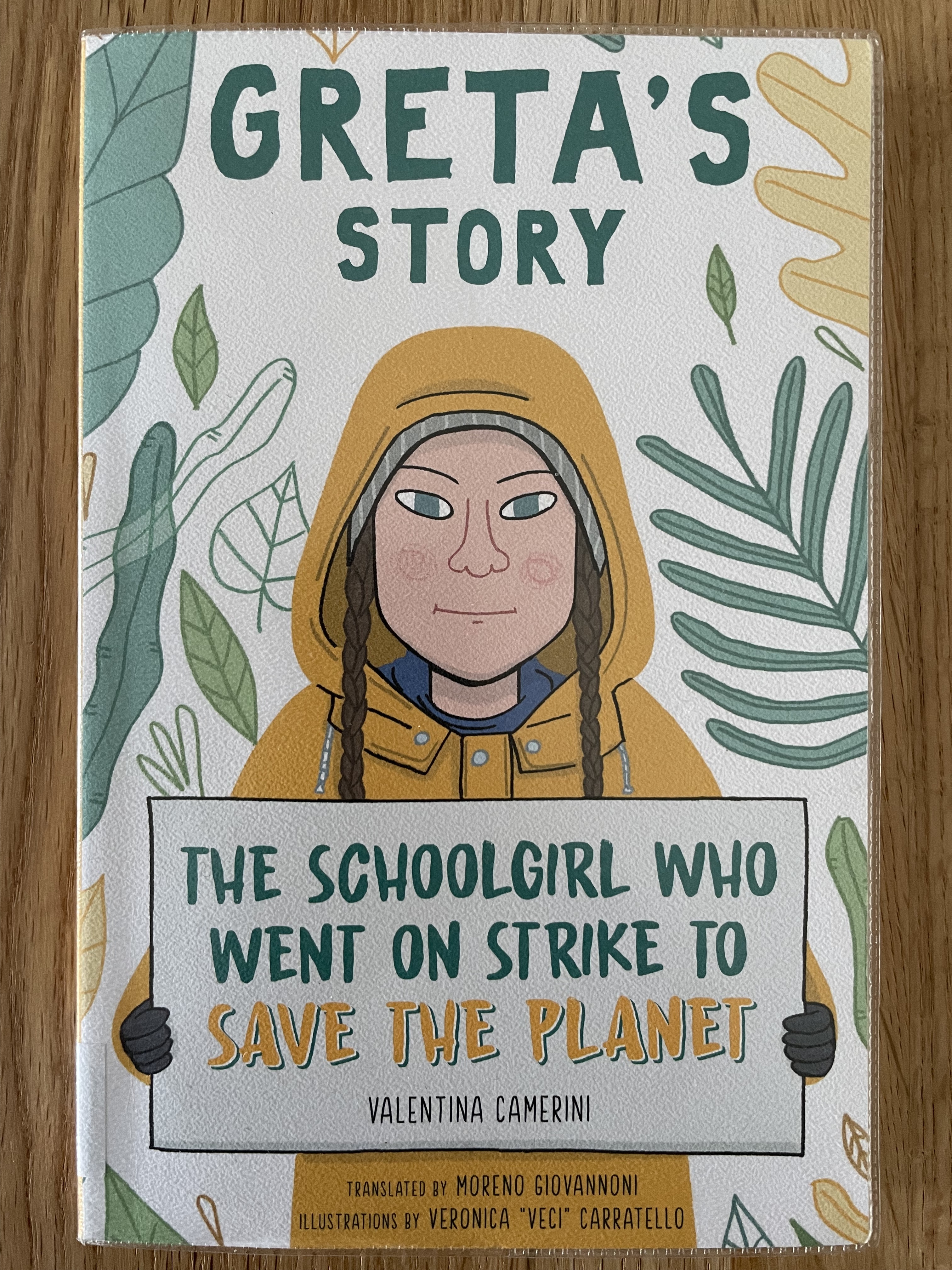
Photo by M. Govinda
In our age of light-speed cyberspace, there probably is no other teenager - who is not a pop-star, TV/media celebrity or sports personality - who has captured the popular imagination so fast than Greta Thunberg. Her combined social media following on Instagram, Twitter, YouTube and Facebook totals approximately 24,132,200 followers, then add the memes, news footage on both mainstream and alternative news media, it is fair to say that Greta is an icon. Her online presence is stratospheric. It’s an impressive fate for someone who at the age of 15 on Monday 20 August 2018, walked out of school, cycled to the Swedish Parliament with some climate change “fact-sheets” and a hand painted sign that read, in Swedish, “School strike for the climate”. She was a one-girl protest, every day for three weeks, then the movement grew. By March 2019, she was nominated for a Nobel Peace Prize and the number of school-students who took part in her strikes reached more than 2,296,704 million people across 131 countries, according to the Fridays for Future, a youth-led global strike movement sparked by Greta’s school strike for climate.
Within the arts and culture sector Greta’s iconographic status is hugely powerful and influential. In 2019 the British indie band The 1975 collaborated with Thunberg on a recording for their album Notes On A Conditional Form (2020), with the financial proceeds donated to the environmental activist group Extinction Rebellion. The track is a melancholic piano, orchestral soundtrack with Thunberg’s spoken words. It ends
So, everyone out there, it is now time for civil disobedience. It is time to rebel
Naomi Klein’s book, “On Fire: The Burning Case for a Green New Deal” (2019) describes a giant papier-mâché figure of Greta, held aloft at a major school climate strike in Düsseldorf, Germany “brow furrowed and braids dangling, like the patron saint of pissed-off kids everywhere.” The merging of street-protest with Italian Catholic-like Mardi Gras carnival, add to Greta’s more-than-human appeal, as prophet or saint.
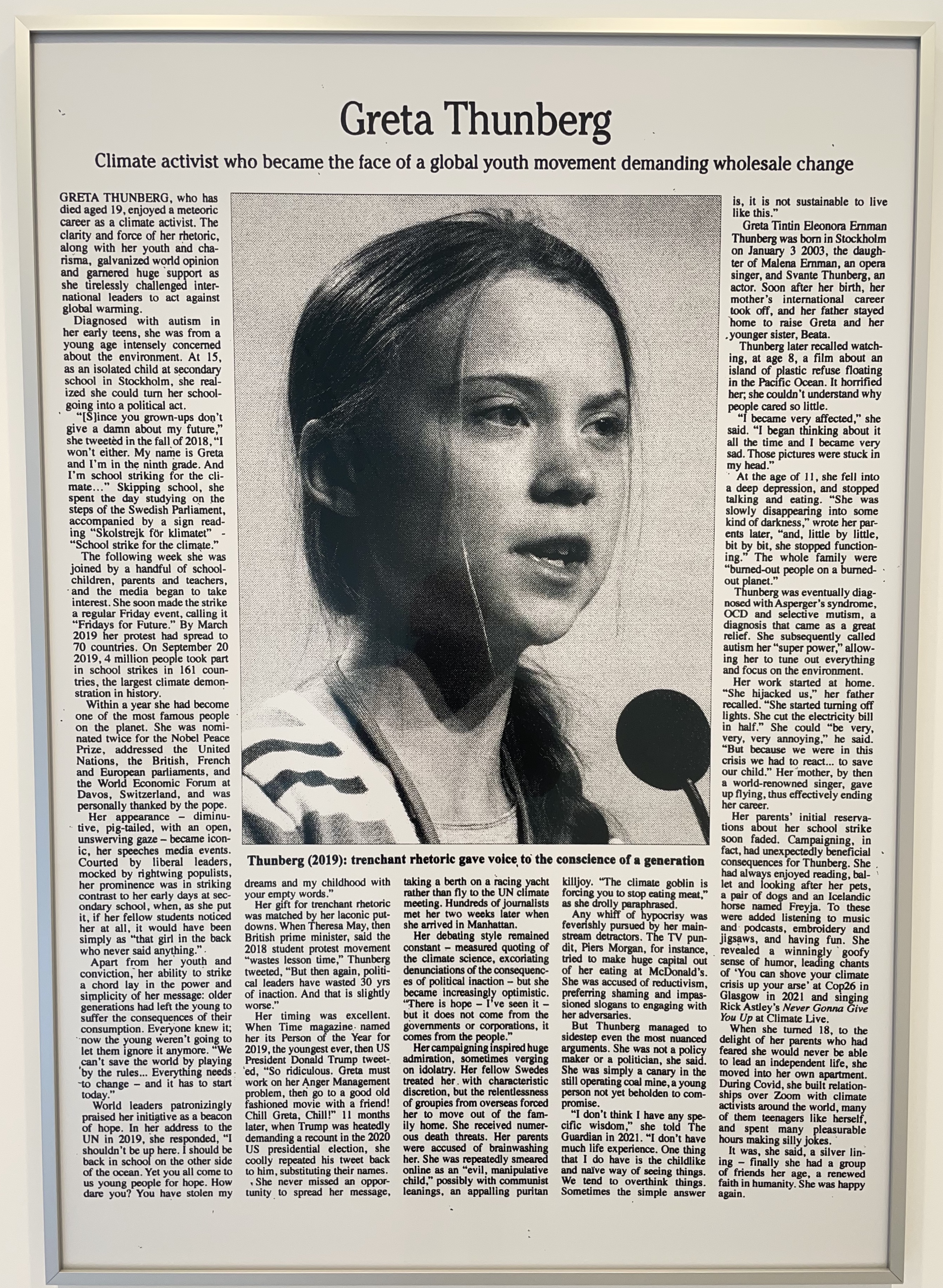
Untitled (Greta), 2023 by Adam McEwen. Courtesy Gagosian
In her home country of Sweden, a church caused a furore in 2018 when it announced on Twitter that:
Jesus of Nazareth has now appointed one of his successors, namely Greta Thunberg.
Street artist Jody Thomas completed a 15-metre high mural portrait of Thunberg in Bristol, a major city in south-west England, on the wall of a multi-purpose creative hub. It was a temporary artwork completed in May 2019 and stayed up during lockdown until July 2021. The image shows Greta, her hair tied in her characteristic child-like plaits, staring at passers-by, unsmiling, her face half-immersed under seawater. The ice-blue of the water implies melting ice-caps – a polar bear is underwater, while above Greta there is a hot, stormy sky of red, fiery yellow and ominous grey clouds. It’s a monumental image with the intention to stop the public from their day to day activities as Greta looks out, while impending climate disaster consumes her being, intent on inducing guilt and complicitness for contributing to global warming. The street mural draws associations with numerous paintings throughout centuries depicting the biblical story of Noah’s ark and the 40-day deluge.
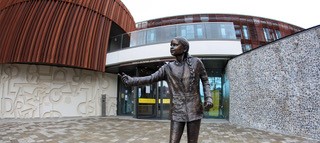
Greta Thunberg statue at Winchester University, England
Photo Credit: Dominic Parkes Photograph
Another public artwork, a £24,000 life-sized statue of Greta was commissioned by The University of Westminster in 2019 and unveiled on 30 March 2021, during the Covid-19 pandemic. The bronze-cast statue, titled Make a Difference was the work of artist Christine Charlesworth, it shows Greta in public address stance, standing on a short-raised block so that she is approximately at eye-level to the public, her right-hand gesturing out, like a street preacher, beseeching the public to listen to her. The unveiling of the work on 30 March 2021, at the height of a long winter lockdown in the UK, stirred student and public backlash with calls that it was a “vanity project” that the funds could have been put to better use during a financially and mentally crippling lockdown. Yet despite vocal criticism, there are plans to erect identical statues in the cities of Portsmouth and Southampton.
The environmental artist Sean Corcoran, based in Ireland, who specialises in creating sand art, created a large portrait of Greta in the sands by a sea-cove, which as the tide rose, was washed away and vanished. The image of Greta is one where she is depicted in calm pensive pose, staring out again, unsmiling, face leaning delicately over her intertwined hands.
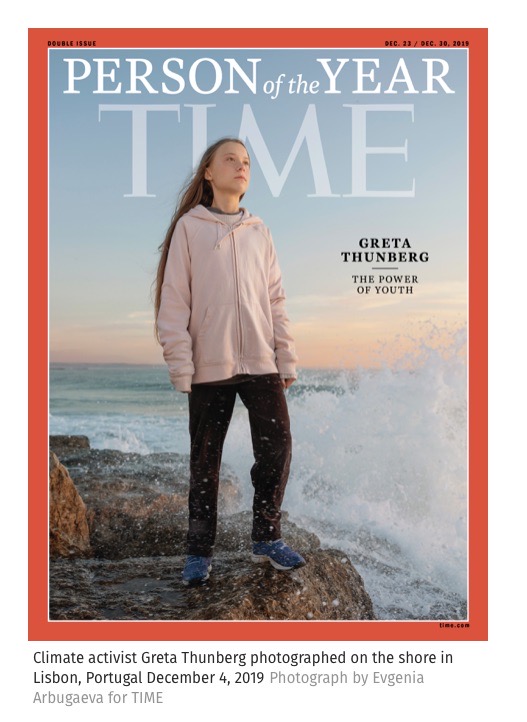
Greta was named Time magazine’s Person of the Year in December 2019. The front cover photograph was shot on the shore of Lisbon, Portugal by Evgenia Arbugaeva, who was born in Tiksi, a town located on the shore of the Laptev Sea in the Republic of Yakitia in Siberia. Her images capture remote worlds and people of the Russian Arctic. It is this image that is the most arresting: Greta is photographed, standing on the edge of a rocky coastline, the sea waves crashing towards her, her face tilted slightly upwards as if she is gazing out into the heavens, wearing a simple muted pale pink hoodie, her long hair unplaited. It’s the classic sunset light, conveying a strength and spiritual calm, beholding an elemental power. The photographer, in an interview with TIME magazine, said that she wanted to capture the spirit of the young activist. Arbugaeva started by “creating a mood board with references to Botticelli, Monet, Norse mythology, tarot cards, and Romantic period art”. The image undoubtedly references the German Romantic artist Caspar David Friedrich’s 1818 painting Wanderer above the Sea of Fog, where a man standing with his back facing the spectator stands on a rocky precipice looking out over a thick sea of fog, contemplating the power of the natural world, it’s a heroic evocation of the sublime and human solitude.
A recent exhibition in London’s exclusive Mayfair district at the Gagosian, showed a series of new work by the London born, New York residing contemporary artist Adam McEwen. In the old tradition of print newspaper obituaries, among the seven living icons from pop stars to a Hindu guru, McEwen eulogises over the death of Greta Thunberg (pictured), the “climate activist who became the face of a global youth movement demanding wholesale change”. His words celebrates her brief lifetime and achievements, while resisting any false narrative of the cause of her death, she is immortalised at aged 19. The work invites us to feel, without sentimentality, her loss to the world.
The iconography of Greta Thunberg in many images render her as both ordinary, yet stoic, “pissed off” and powerful. As a teen activist, she rarely smiled in those carefully composed photographs, she was described as “stony-faced”, possessing a “steely composure”, a “super-power” brought about by her Asperger syndrome. Like a saint or prophet, she speaks like a young seer, predicting catastrophic disasters of biblical proportion should humankind not make radical life-changes to reduce the impact of carbon emissions on the planet.

Photo by M. Govinda
Within public and school libraries, online stores and bookshops there are numerous childrens and teenage educational books available telling the story of Greta’s battle with giants (i.e., adults), she is the self-described “she/her Autistic climate justice activist” David taking on Goliath. These books are promoted to encourage eco-activism amongst the young, they need to feel the panic. Taking inspiration from Greta’s life, the young are encouraged to start with raising concerns about climate change to begin the only important existential quest, to save our planet.
Her Asperger’s Syndrome is frequently cited in all the narratives about Thunberg. Naomi Klein and many others, including Greta herself, called it her superpower. Thunberg has said that it makes her see things in black and white, “It makes me different, and being different is a gift, I would say”. It’s a developmental disorder, young people with Asperger find it hard to relate to other people socially and their patterns of behaviour and thinking can be rigid and repetitive. People with the syndrome become obsessive about one subject or interest, will only engage in a small range of activities, it interferes in their everyday life, and they tend not to have any social or recreational interests. People with Asperger syndrome have highly focused interests, from an early age, which can be life-long. For example, one person loved collecting rubbish, with encouragement this particular person developed an interest in recycling and the environment. For Thunberg, discovering climate change and global warming, that the world’s temperature is soaring and set to rise by 3 degrees Centigrade in this century, partly led her to a deep depression at 11 years old, stopping her from going to school and losing over 9kgs in two months. Becoming a climate activist save her life, it gave her a purpose. It became her obsession.
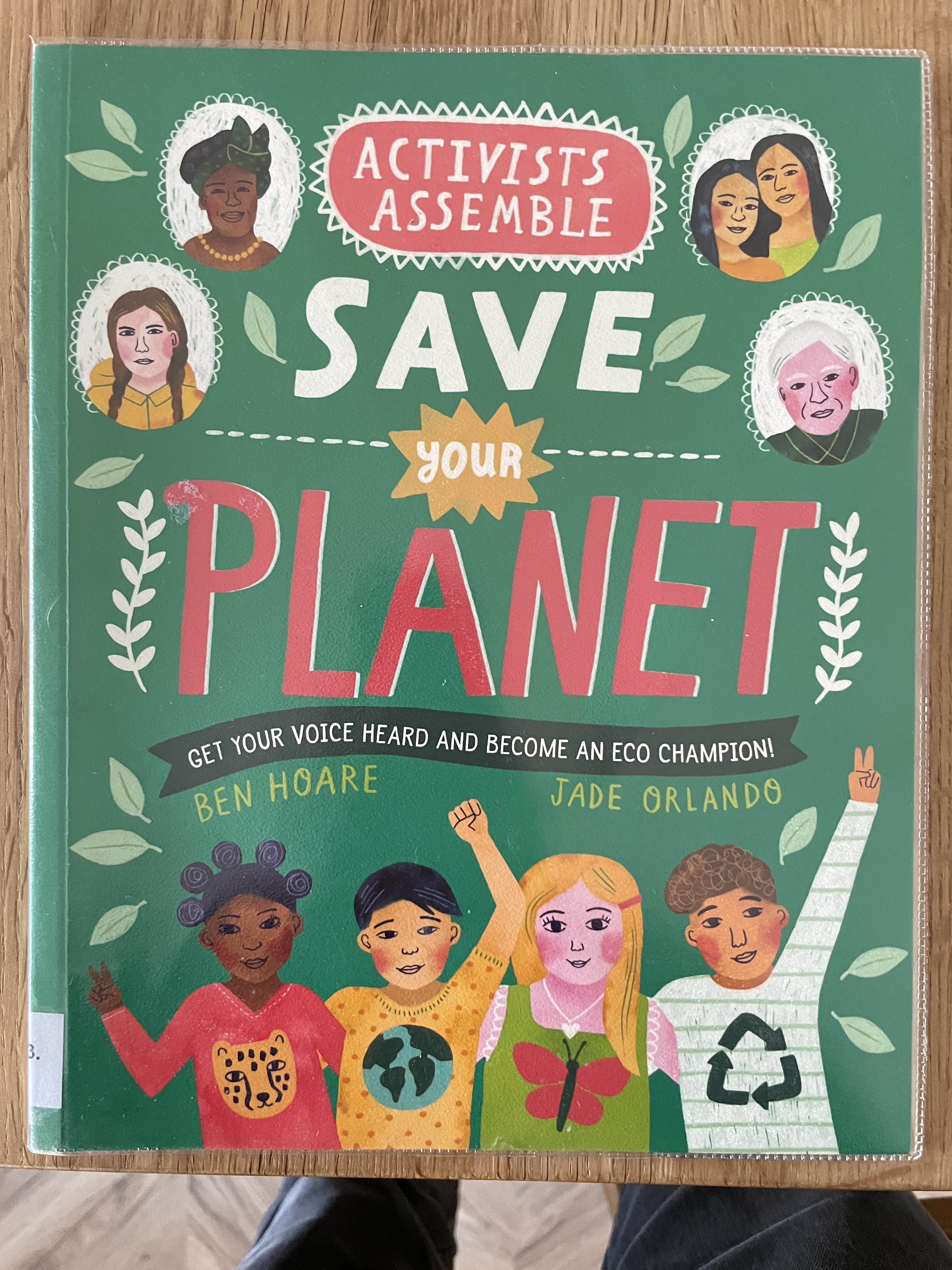
Photo by M. Govinda
However, is seeing global warming in such black and white terms a superpower? Or is it a psychological state of fear caused by adult climate alarmists and accelerated by her Asperger diagnosis? In an interview with Thunberg for Dazed in late March 2019, the sixteen year old talks about “the depression of climate change”. She says that she was about 8-9 years old when she learned about the climate crisis in school, she cites Al Gore’s film An Inconvenient Truth and reading writers/activists Naomi Klein, George Monbiot and climatologist James Hansen. The American novelist and Calvinist, Marilynne Robinson has written and spoken about the shortcomings of neuroscience and the diagnosis of those with neurological disorders and how this branch of science excludes complexity – “the factor that introduces individuality with all its attendant mysteries…” she goes on to say that “neuroscience is remarkable among sciences for its tendency to bypass hypothesis and even theory and go directly to assertion”. In this context, Thunberg’s action at 16 years old is simple, she needs to deliver a transference of absolute fear that she genuinely feels, onto us, the public, particularly the young:
Our house is on fire. I’m here to say, our house is on fire. Adults keep saying: ‘We owe it to the young people to give them hope.’ But I don’t want your hope. I don’t want you to be hopeful. I want you to panic. I want you to feel the fear I feel every day. And then I want you to act.
Such a position, induced by fear, means that it is impossible to have a nuanced debate or discussion on global warming and climate change. It is above democracy. The movement that Greta sparked, the school climate strikes that take place across many countries, will demand an embargo on Russian fossil fuels and stand with Ukraine. However, when real action is taken by some European nations to sever themselves from Russian energy supplies, such as Germany’s decision to expand coal extraction or Poland’s greater energy autonomy through domestic coal, which produces around 80% of Poland’s power, Thunberg crusades against, what in her opinion, is the greatest of evil - coal extraction. Her protest against the expansion of a coal mine in western Germany led to a highly staged, photogenic arrest for the media (she was released without charge).

Photo by M. Govinda
However, Greta Thunberg is no Peter Pan, over five and a half years have passed since her first solo protest outside Sweden’s parliament. Greta is now 20 years old and her tactic of raising the alarm bell over global warming has moved further towards an intersectional anti-capitalist, leftist position. The middle class young woman, whose net worth is said to be about 1 million US dollars has set up The Greta Thunberg Foundation and its grant-giving aims are underpinned more by climate justice for poorer countries that have been effected by extreme weather in Pakistan and Somalia, where people have been displaced by catastrophic floods. She is no longer the Scandinavian poster girl of melting polar ice-caps and displaced Polar Bears. She even laughs, giggles and smiles more on camera than in her teenage years.
Her youthful intelligence, her sincerity to save the planet, to mitigate global warming is genuine. However, her reluctance to engage in public debate with her critics, or those who have a different perspective to her is highly problematic and, although she states that democracy is the only solution to reduce CO2 emissions, that the public needs to put massive pressure on government and during elections, she fails to engage in open public debate. To do so would mean to abandon her demagoguery and climb down from the iconographic hype that she has been created by herself and by the media, celebrities and the many artists who fawn over her. I searched high and low on the internet to see whether Thunberg had ever taken part in a debate to discuss what could be done to “save our planet”, all I found was rhetoric, and finger-wagging at hopeless politicians and corporates:
Beyoncé was wrong. It is not girls who run the world. It is run by politicians, corporations and financial interests – mainly represented by white, privileged, middle-aged, straight cis men. The Guardian, 22 October 2022.
This kind of high-minded accusation is no better than a twitter spat, and Greta has dished out a few against adults who really should know better, but a spat is not a debate.
As Thunberg enters adulthood, it seems remote that she will debate and argue her position in the short term, with reason, to find solutions to the extreme climate catastrophes that destroy human lives and livelihood. Instead she encourages greater civil disobedience. Thus, the activists who engage in direct-action who are involved with Just Stop Oil, Extinction Rebellion and Insulate Britain to name a few, have become her disciples. Instead of winning public support, these groups have only alienated the majority, particularly working class people. It is highly unlikely that she would debate with someone like Bjørn Lomberg, author of False Alarm: How Climate Change Panic Costs Us Trillions, Hurts the Poor and Fails to Fix the Planet, who agrees that “climate change is real and its impacts are mostly negative”, or Michael Shellenberger author of Apocalypse Never. Both authors are green pragmatists, with realistic ideas on how to address environmental and energy concerns. Both agree that Greta and her fellow band of doomsayer alarmists, screeching out loud that “the end is nigh” will do more damage to humanity and the planet than fix it.
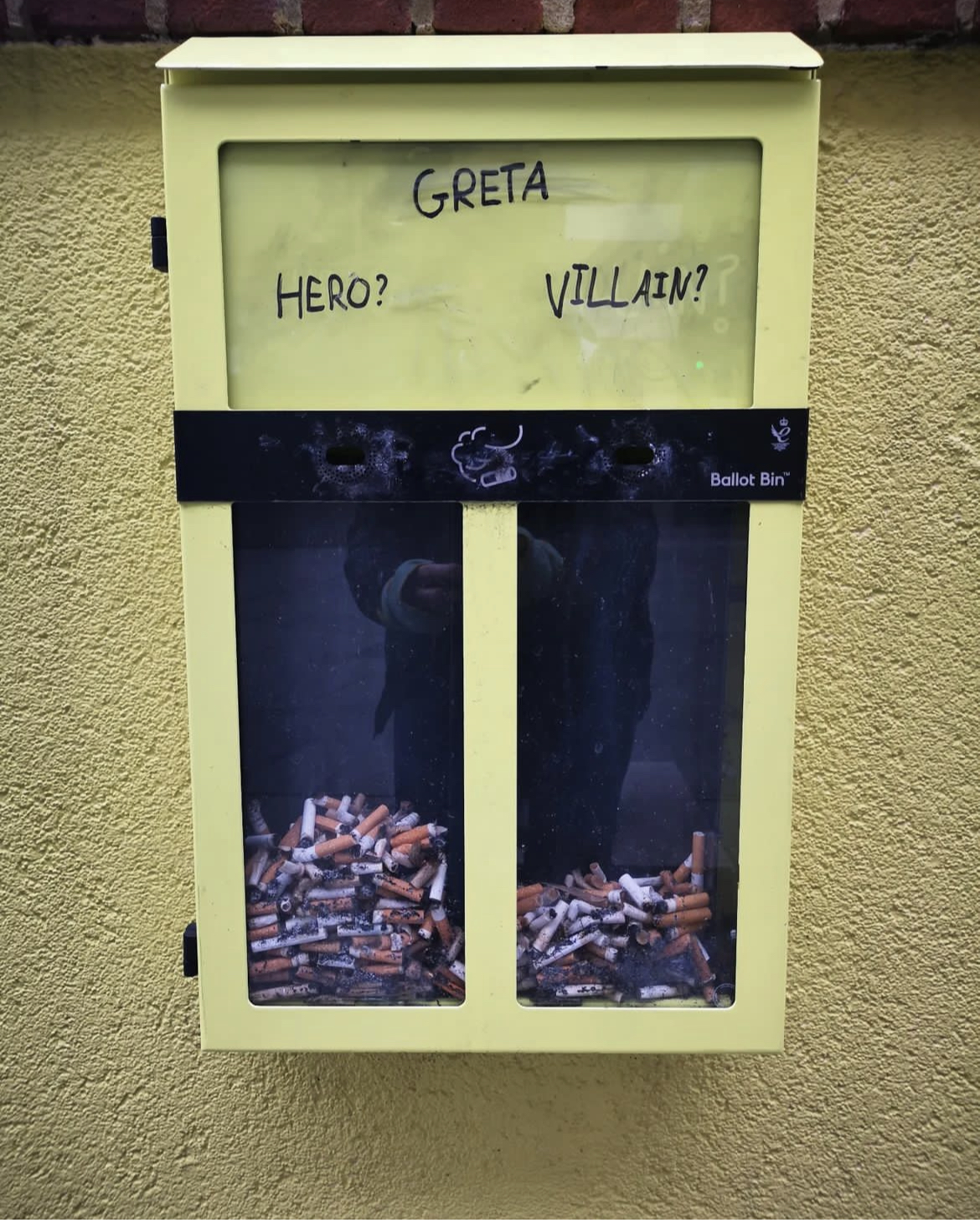
Credits: Amanda Jobson
We have to ask ourselves how and why has Greta Thunberg reached such messianic status? Her message is so simple, as she says herself, she sees everything in black and white yet the artworld addresses her as a church would address holiness when addressing the “climate emergency”. Perhaps the disillusionment with Judeo-Christianity AND with The Enlightenment, which paved the way for the age of wonder and industry, have left the affluent middle classes and its cultural elite in an existential vacuum.
The complex question of the basic need for energy to live fulfilling lives, balanced with a love of natural beauty, is swept under the carpet, as it is much easier to forecast the eve of destruction than it is to consider the complex dilemma of how to live in a world of abundance while also safeguarding our environment. Placing Greta Thunberg on a pedestal will not address these complex questions.


